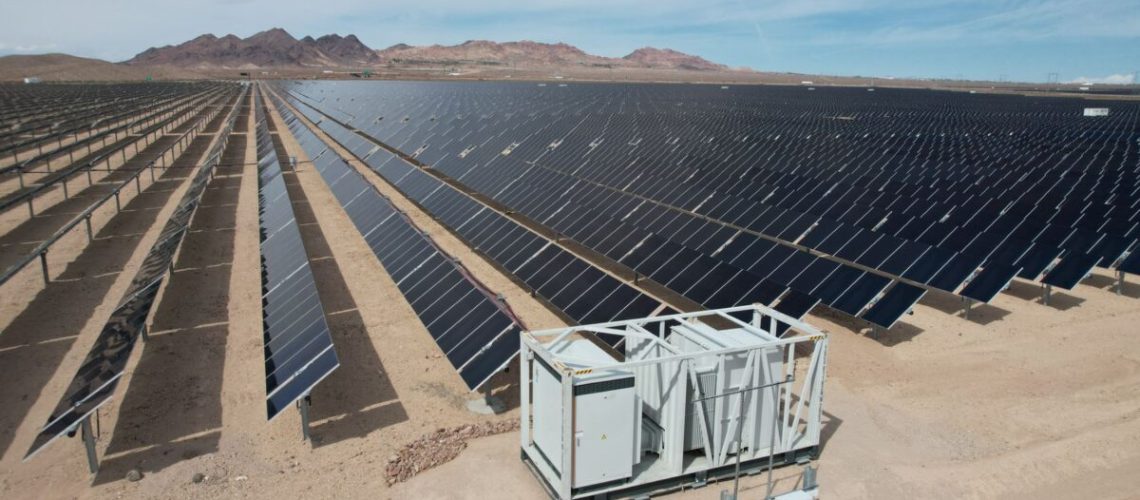Among the top six U.S. states in terms of solar irradiance and blessed with a large land area of more than 110k square miles, it should come as no surprise that Nevada is well suited for ground-mounted or utility-scale solar development. In fact, the Silver State is home to nearly 5.4 GW of solar energy resources, placing it sixth in the U.S. among solar states, according to the Solar Energy Industries Association (SEIA).
Using data going back to 1998, the National Renewable Energy Laboratory shows much of the southern portion of Nevada blending into the region of highest solar resource in the nation, with portions of desert land around Las Vegas carrying 5.5 kWh and 5.75 kWh per square meter of daily solar irradiance.
As the state nears a feat of providing enough power from solar to one million homes, the state is at a turning point for solar deployments, with more than 5.8 GW of projected projects to be installed in the next five years, which would more than double its current output, according to SEIA’s data.
Despite its vast utility-scale solar arrays, Nevada consumes six times more energy than it produces, according to the Energy Information Administration. This is likely due to the energy used to power Las Vegas, the 25th most populous city in the country, located in an isolated desert region. In 2022, solar represented 23% of the state’s energy mix, with natural gas still providing a 64.8% majority, while the remainder came from coal (5.2%), geothermal (5%) and hydroelectric (2%).
Two of the state’s remaining coal plants, located in southern Nevada, closed over the past decade, while a third coal-fired power plant, the 522 MW North Valmy plant that supplies electricity to northern Nevada, is scheduled to retire in 2025. Coal retirements around the Southwest provide numerous opportunities for utility solar-plus-storage deployments, and Nevada is no exception to this growing trend.
Incentives
Nevada’s original net metering framework dates back to 1997 and was amended eight times, most recently in 2017. Systems of up to 1 MW generating capacity from solar, wind, geothermal, biomass or hydro are eligible, although systems greater than 25 kilowatts (kW) in capacity may be subject to additional costs at the utility’s discretion, according to DSIRE.
Net metering was axed in the state from 2015 to 2016, but its current framework provides surplus electricity generation credited at 95% of the full retail rate until the installed net metering capacity reaches 80 MW. Currently, credits for new net metering customers will be valued at 75% of the retail rate of electricity. The state’s largest utility NV Energy, operated by Warren Buffet’s Berkshire Hathaway Energy, allows net metering for systems installed in both of its territories in northern and southern Nevada.
Community solar
Currently Nevada does not have a statewide shared-access community solar program, though for several years utility NV Energy has constructed several utility-provided community facilities to residents in its service territories. A prior community solar bill under SB-392 was vetoed by Nevada Governor Brian Sandoval in June 2017.
Under NV Energy’s Expanded Solar Access Program (ESAP), codified in-state as AB 465, the utility allows a limited number of residential and business customers to use the utility’s shared community solar systems. The framework directed the utility to construct three to 10 solar access programs, with 25% of shared solar programs reserved for low-income customers and 50% reserved for residential customers unable to install rooftop solar.
Noteworthy installation
Located in Boulder City, Nev., Arevon Energy completed construction of the Townsite Solar and Storage project in January 2022. Situated in the southern portion of the state where two of NV Energy’s coal facilities were shuttered, the 232 MW (DC) utility solar and 360 MWh storage facility provides grid stability in a region where energy consumption remains high in Las Vegas, Justin Johnson, chief operating officer of Arevon Energy, told pv magazine USA in early 2023.
Incorporating 528,084 U.S.-made First Solar Series 6 modules, Nextracker tracking hardware and Tesla Megapack lithium-ion batteries, Townsite produces more than 500,000 MWh per year of clean energy, enough to power 60,000 homes per year, and serves two municipalities in NV Energy’s service territory, including Las Vegas, Johnson said. The facility interconnects underground to a 230 kV substation, before power travels overhead via a tie-in to the Mead Substation near Boulder City.
Construction of the 1,053-acre solar-plus-storage facility took 14 months, spanning from November 2020 to January 2022, with U.S. Secretary of Energy Jennifer M. Granholm visiting the facility at a January 11, 2022 ribbon-cutting event. Rosindin Electric served as Primergy’s general contractor during construction of the project.
The Townsite project was part of Gigawatt 1, a utility-scale solar project portfolio first proposed by Arevon’s predecessor Capital Dynamics, Tenaska Power Services, and Switch in February 2018. The Gigawatt 1 portfolio was designed to generate the lowest cost solar power in Nevada and generate enough clean energy to power nearly one million homes.
Since 2018, NV Energy has purchased power from 14 utility solar projects with about 3.2 GW of total generating capacity, alongside an additional 1.5 GW of nameplate capacity storage systems, according to a utility fact sheet. Over the next two years, the utility is expected to add another 1.2 GW of solar capacity from the Gemini Solar (690 MW) plus storage (1.42 GWh) facility, Southern Bighorn Solar (300 MW) plus storage (540 MWh) facility, and Arrow Canyon Solar (200 MW) plus storage (455 MWh) facility.
The last stop on the pv magazine tour of 50 states was Wyoming, and next we move to Utah. View the completed states here.



